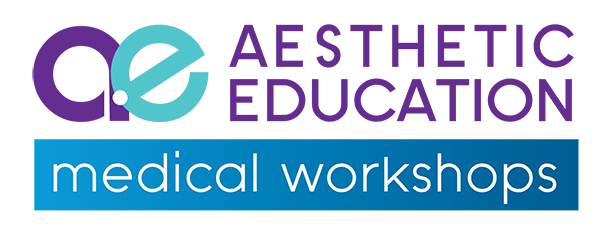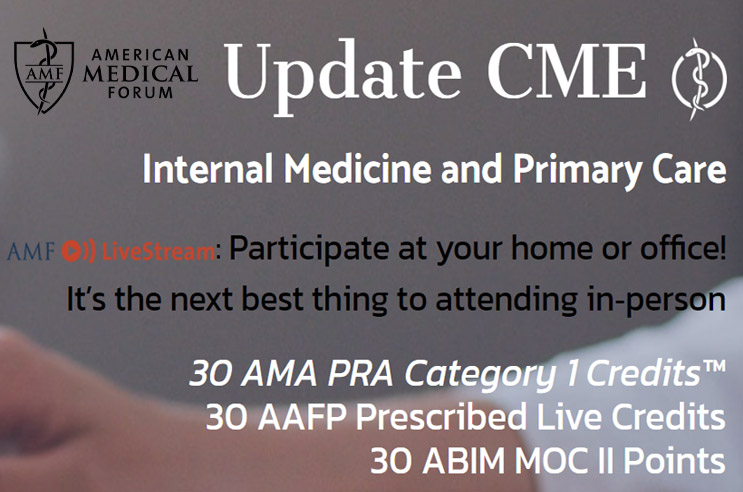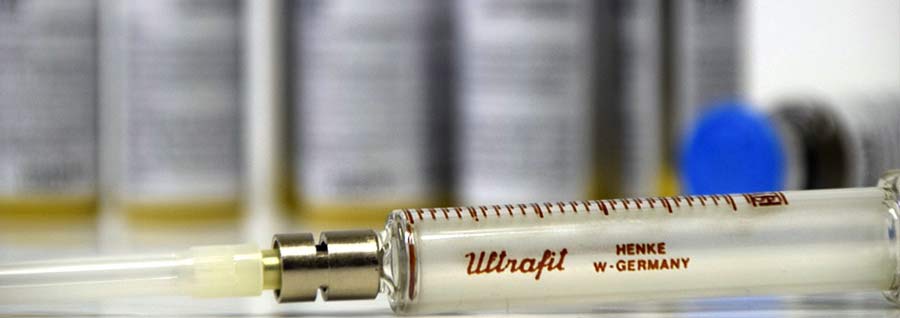About Our Botox and Dermal Filler Training Course

Aesthetic Education's most popular hands-on training course offers doctors, physician assistants, nurse practitioners, dentists, and registered nurses the opportunity to learn the latest Cosmetic Botulinum Toxin (Botox®) and Hyaluronic Acid dermal filler training (Juvederm, Restylane, Belotero).
Learning advanced hands-on techniques is vital to any aesthetic procedures practice. This course will help healthcare professionals understand how to safely and correctly work with these aesthetic injections, and efficiently utilize different products with confidence.
Comprehensive Training Approach
Instructors will help you learn how to select the right product and treatment protocol for both static and dynamic wrinkles of the face using Botox, Dysport, and Xeomin in addition to the hyaluronic acid dermal fillers safely and effectively. All courses are delivered by our faculty of experienced physician instructors and contain comprehensive protocols that will transform you into a master of the procedure.
Blended Learning Method
The Botox CME and Dermal Filler Training Course combines video learning followed by live hands-on training for the best results. Our training requires participants to:
- Complete the full-length streaming online course sent immediately upon registration
- Pass a post-test prior to attending the live hands-on session
- Attend live training where all protocols are reviewed, followed by Q&A and discussion
- Practice on live models under direct MD supervision in small groups (6 or fewer participants)
Hands-On Practice with Real Products
All registered and properly licensed participants will have the opportunity to perform injections using real Botox and Juvederm dermal filler on their own patient under the direct supervision of our MD instructor. Our instructors will review your technique one-on-one and offer you unique suggestions to improve your skills.
Evidence-Based Techniques
Only the classic injection techniques and treatment protocols as described in the medical literature are taught. Strong emphasis is placed on learning the facial muscles and proper injection depths to ensure great results. You will be ready to practice this procedure safely and effectively at the end of our training course.
Comprehensive Product Coverage
We provide the most comprehensive dermal filler training - Juvederm hands-on and Juvederm certification to all healthcare professionals who aim to expand their skills or integrate within their practice. The course is designed to help providers develop understanding of:
- Facial areas and anatomy
- Patient selection and consultation
- Product selection and comparison
- Strategic placement techniques
- Restoring a smoother appearance safely
Flexible Training Options
You can take both the Botox and Dermal Fillers (Juvederm, Restylane, Belotero) Training Certification together, or just take the Botox Certification course alone. Providers who wish to learn Botox without Juvederm training and other dermal fillers training can register for only that portion of the course at a reduced tuition rate.
Post-Course Support
The course is well-designed to cover everything that will help you in your practice. Instructors ensure that you fully understand the lectures and become comfortable in performing Botox and dermal filler procedures after the event. For further assistance, we encourage contact with our faculty to address your questions after the live course is over. Our physicians always give out their email addresses and promptly answer any queries after the event.
Botox Training Course - Topics Covered
Introduction to Static and Dynamic Wrinkles
- Summary of facial changes with aging
- Psychology and social aspects of facial aging
- Review of non-invasive facial procedures
- The market for these services
- Facial skin anatomy
- Facial muscle anatomy and physiology
Botulinum Toxin (BTX-A) Training
- What is Botulinum Toxin?
- History of use in medical aesthetics
- FDA approved indications for use
- Off-label uses and applications
- Reconstitution and dilution techniques
- Choosing the right syringe to use
- Patient consent procedures
- Contraindications and precautions
- Virtually Painless Injection Techniques and Dosage:
- Glabellar lines (central brow)
- Forehead wrinkles
- Crow's feet (lateral orbital lines)
- Lower lid wrinkles
- Brow lift techniques
- Bunny lines (nasal wrinkles)
- Upper lip wrinkles (smoker's lines)
- Lip augmentation with Botox
- Gummy smile correction
- Touch-up procedures
- Managing complications
- Follow-up protocols
- HANDS-ON INJECTION opportunity for qualified attendees
Facial Fillers Training
- Types of dermal fillers
- FDA approved indications
- Contraindications and warnings
- Patient consent procedures
- Depth of injection protocols
- Superficial dermis
- Mid dermis
- Deep dermis
- Dental blocks and local anesthetics
- Virtually Painless Injection Techniques and Dosage Protocols:
- Nasolabial folds
- Marionette lines
- Lip augmentation techniques
- Mouth corners (oral commissures)
- Smoker's lines (perioral lines)
- Forehead wrinkles at rest
- Cheek augmentation
- Under-eye hollows (tear troughs)
- Touch-up procedures
- Using layered treatments successfully
- Managing complications and adverse events
- Emergency procedures (vascular occlusion)
- HANDS-ON INJECTION opportunity for qualified attendees
Business & Practice Management
- Setting up your aesthetic practice
- Pricing strategies and ROI
- Marketing your services
- Patient consultation best practices
- Building a loyal patient base
Upcoming Botox Training Dates & Venues
Choose from 60 upcoming training sessions across the United States
| # | Date & Location | Course Details | Organizer | Details |
|---|---|---|---|---|
| 1 |
Dec 06, 2025 Brooklin, NY |
Botox Training in
Brooklin
Comprehensive Botox Training in Brooklyn, NY: Master Botulinum Toxin Techniques |
Empire Medical Training | View Details |
| 2 |
Dec 06, 2025 Cleveland, OH |
Botox Training in
Cleveland
Expert Botox Training in Cleveland, OH: Master Botulinum Toxin Techniques |
Empire Medical Training | View Details |
| 3 |
Dec 06, 2025 Oklahoma City, OK |
Botox Training in
Oklahoma City
Expert Botox Training in Oklahoma City, OK: Elevate Your Aesthetic Skills |
Empire Medical Training | View Details |
| 4 |
Dec 06, 2025 Anaheim, CA |
Botox Training in
Anaheim
Expert Botulinum Toxin (Botox) Training in Anaheim, CA: Elevate Your Injectable Skills |
Empire Medical Training | View Details |
| 5 |
Dec 06, 2025 Louisville, KY |
Botox Training in
Louisville
Comprehensive Botulinum Toxin (Botox) Training in Louisville, KY: Elevate Your Aesthetic Skills |
Empire Medical Training | View Details |
| 6 |
Dec 13, 2025 Miami Beach, FL |
Botox Training in
Miami Beach
Expert Botulinum Toxin (Botox) Training in Miami & Miami Beach, FL: Elevate Your Aesthetic Skills |
Empire Medical Training | View Details |
| 7 |
Dec 13, 2025 New York, NY |
Botox Training in
New York
Botox Training and Certification - Accredited CME Course |
Empire Medical Training | View Details |
| 8 |
Dec 13, 2025 Pittsburgh, PA |
Botox Training in
Pittsburgh
Comprehensive Botulinum Toxin (Botox) Training in Pittsburgh, PA: Elevate Your Aesthetic Skills |
Empire Medical Training | View Details |
| 9 |
Dec 13, 2025 Detroit, MI |
Botox Training in
Detroit
Top Botulinum Toxin (Botox) Training Courses in Detroit, MI: Elevate Your Aesthetic Skills |
Empire Medical Training | View Details |
| 10 |
Dec 13, 2025 Las Vegas, NV |
Botox Training in
Las Vegas
Expert Botox Training in Las Vegas, NV: Master Botulinum Toxin Techniques |
Empire Medical Training | View Details |
| 11 |
Dec 13, 2025 Online Course, web |
Botox Training in
Online Course
Expert Botulinum Toxin (Botox) Training at Empire Virtual Training: Enhance Your Skills |
Empire Medical Training | View Details |
| 12 |
Dec 13, 2025 Austin, TX |
Botox Training in
Austin
Expert Botox Training in Austin, TX: Elevate Your Aesthetic Skills |
Empire Medical Training | View Details |
| 13 |
Dec 13, 2025 Jacksonville, FL |
Botox Training in
Jacksonville
Top Botox Training Courses in Jacksonville, FL: Become a Certified Practitioner |
Empire Medical Training | View Details |
| 14 |
Dec 20, 2025 New York, NY |
Botox Training in
New York
Expert Botulinum Toxin (Botox) Training in New York City, NY: Elevate Your Aesthetic Skills |
Empire Medical Training | View Details |
| 15 |
Jan 03, 2026 Fort Lauderdale, FL |
Botox Training in
Fort Lauderdale
Botulinum Toxin (Botox) Training in Fort Lauderdale: Become a Certified Expert Today! |
Empire Medical Training | View Details |
| 16 |
Jan 10, 2026 Orlando, FL |
Botox Training in
Orlando
Expert Botulinum Toxin (Botox) Training in Orlando, FL: Elevate Your Aesthetic Skills |
Empire Medical Training | View Details |
| 17 |
Jan 10, 2026 Las Vegas, NV |
Botox Training in
Las Vegas
Expert Botox Training in Las Vegas, NV: Master Botulinum Toxin Techniques |
Empire Medical Training | View Details |
| 18 |
Jan 10, 2026 Charlotte, NC |
Botox Training in
Charlotte
Top Botulinum Toxin (Botox) Training Courses in Charlotte, NC |
Empire Medical Training | View Details |
| 19 |
Jan 17, 2026 New Orleans, LA |
Botox Training in
New Orleans
Comprehensive Botulinum Toxin (Botox) Training in New Orleans, LA: Elevate Your Aesthetic Skills |
Empire Medical Training | View Details |
| 20 |
Jan 17, 2026 Boston, MA |
Botox Training in
Boston
Expert Botulinum Toxin (Botox) Training in Boston, MA: Elevate Your Aesthetics Skills |
Empire Medical Training | View Details |
| 21 |
Jan 24, 2026 Brooklin, NY |
Botox Training in
Brooklin
Comprehensive Botox Training in Brooklyn, NY: Master Botulinum Toxin Techniques |
Empire Medical Training | View Details |
| 22 |
Jan 24, 2026 San Francisco, CA |
Botox Training in
San Francisco
Top Botulinum Toxin (Botox) Training Programs in San Francisco, CA |
Empire Medical Training | View Details |
| 23 |
Jan 31, 2026 Chicago, IL |
Botox Training in
Chicago
Comprehensive Botulinum Toxin (Botox) Training in Chicago, IL: Elevate Your Skills |
Empire Medical Training | View Details |
| 24 |
Jan 31, 2026 San Juan, PR |
Botox Training in
San Juan
Top Botulinum Toxin (Botox) Training Courses in Puerto Rico: Elevate Your Aesthetic Skills |
Empire Medical Training | View Details |
| 25 |
Jan 31, 2026 San Juan, PR |
Botox Training in
San Juan
Top Botulinum Toxin (Botox) Training Courses in Puerto Rico: Elevate Your Aesthetic Skills |
Empire Medical Training | View Details |
| 26 |
Feb 07, 2026 Philadelphia, PA |
Botox Training in
Philadelphia
Comprehensive Botox Training in Philadelphia, PA: Master Botulinum Toxin Techniques |
Empire Medical Training | View Details |
| 27 |
Feb 07, 2026 Dallas, TX |
Botox Training in
Dallas
Top Botulinum Toxin (Botox) Training Courses in Dallas, TX: Elevate Your Aesthetic Skills |
Empire Medical Training | View Details |
| 28 |
Feb 08, 2026 Long Island, NY |
Botox Training in
Long Island
Comprehensive Botulinum Toxin (Botox) Training Programs in Long Island, NY |
Empire Medical Training | View Details |
| 29 |
Feb 13, 2026 New York, NY |
Botox Training in
New York
Expert Botulinum Toxin (Botox) Training in New York City, NY: Elevate Your Aesthetic Skills |
Empire Medical Training | View Details |
| 30 |
Feb 13, 2026 Fort Lauderdale, FL |
Botox Training in
Fort Lauderdale
Botulinum Toxin (Botox) Training in Fort Lauderdale: Become a Certified Expert Today! |
Empire Medical Training | View Details |
| 31 |
Feb 14, 2026 Jacksonville, FL |
Botox Training in
Jacksonville
Top Botox Training Courses in Jacksonville, FL: Become a Certified Practitioner |
Empire Medical Training | View Details |
| 32 |
Feb 14, 2026 Atlanta, GA |
Botox Training in
Atlanta
Comprehensive Botox Training in Atlanta, GA: Elevate Your Aesthetic Skills |
Empire Medical Training | View Details |
| 33 |
Feb 21, 2026 Newark, NJ |
Botox Training in
Newark
Expert Botulinum Toxin (Botox) Training in Newark, NJ: Enhance Your Aesthetic Skills |
Empire Medical Training | View Details |
| 34 |
Feb 21, 2026 Naples, FL |
Botox Training in
Naples
Master Botulinum Toxin (Botox) Training in Naples, FL: Elevate Your Aesthetic Skills |
Empire Medical Training | View Details |
| 35 |
Feb 21, 2026 Nashville, TN |
Botox Training in
Nashville
Comprehensive Botulinum Toxin (Botox) Training in Nashville, TN: Elevate Your Aesthetic Practice |
Empire Medical Training | View Details |
| 36 |
Feb 21, 2026 Minneapolis, MN |
Botox Training in
Minneapolis
Expert Botulinum Toxin (Botox) Training Courses in Minneapolis, MN |
Empire Medical Training | View Details |
| 37 |
Feb 28, 2026 Las Vegas, NV |
Botox Training in
Las Vegas
Expert Botox Training in Las Vegas, NV: Master Botulinum Toxin Techniques |
Empire Medical Training | View Details |
| 38 |
Feb 28, 2026 Miami Beach, FL |
Botox Training in
Miami Beach
Expert Botulinum Toxin (Botox) Training in Miami & Miami Beach, FL: Elevate Your Aesthetic Skills |
Empire Medical Training | View Details |
| 39 |
Feb 28, 2026 Austin, TX |
Botox Training in
Austin
Expert Botox Training in Austin, TX: Elevate Your Aesthetic Skills |
Empire Medical Training | View Details |
| 40 |
Mar 07, 2026 Detroit, MI |
Botox Training in
Detroit
Comprehensive Botulinum Toxin (Botox) Training in Detroit, MI: Elevate Your Aesthetic Skills |
Empire Medical Training | View Details |
| 41 |
Mar 08, 2026 Brooklin, NY |
Botox Training in
Brooklin
Comprehensive Botox Training in Brooklyn, NY: Master Botulinum Toxin Techniques |
Empire Medical Training | View Details |
| 42 |
Mar 14, 2026 Los Angeles, CA |
Botox Training in
Los Angeles
Expert Botulinum Toxin (Botox) Training in Los Angeles: Elevate Your Aesthetics Skills |
Empire Medical Training | View Details |
| 43 |
Mar 14, 2026 Cleveland, OH |
Botox Training in
Cleveland
Expert Botox Training in Cleveland, OH: Master Botulinum Toxin Techniques |
Empire Medical Training | View Details |
| 44 |
Mar 15, 2026 Long Island, NY |
Botox Training in
Long Island
Comprehensive Botulinum Toxin (Botox) Training Programs in Long Island, NY |
Empire Medical Training | View Details |
| 45 |
Mar 21, 2026 Boston, MA |
Botox Training in
Boston
Expert Botulinum Toxin (Botox) Training in Boston, MA: Elevate Your Aesthetics Skills |
Empire Medical Training | View Details |
| 46 |
Mar 21, 2026 San Francisco, CA |
Botox Training in
San Francisco
Top Botulinum Toxin (Botox) Training Programs in San Francisco, CA |
Empire Medical Training | View Details |
| 47 |
Mar 21, 2026 Orlando, FL |
Botox Training in
Orlando
Expert Botulinum Toxin (Botox) Training in Orlando, FL: Elevate Your Aesthetic Skills |
Empire Medical Training | View Details |
| 48 |
Mar 28, 2026 Jacksonville, FL |
Botox Training in
Jacksonville
Top Botox Training Courses in Jacksonville, FL: Become a Certified Practitioner |
Empire Medical Training | View Details |
| 49 |
Mar 28, 2026 New York, NY |
Botox Training in
New York
Expert Botulinum Toxin (Botox) Training in New York City, NY: Elevate Your Aesthetic Skills |
Empire Medical Training | View Details |
| 50 |
Mar 28, 2026 Denver, CO |
Botox Training in
Denver
Comprehensive Botulinum Toxin (Botox) Training in Denver, CO: Elevate Your Aesthetic Skills |
Empire Medical Training | View Details |
| 51 |
Apr 04, 2026 Las Vegas, NV |
Botox Training in
Las Vegas
Expert Botox Training in Las Vegas, NV: Master Botulinum Toxin Techniques |
Empire Medical Training | View Details |
| 52 |
Apr 04, 2026 Alexandria, VA |
Botox Training in
Alexandria
Expert Botulinum Toxin (Botox) Training in Alexandria, VA: Elevate Your Aesthetic Skills |
Empire Medical Training | View Details |
| 53 |
Apr 05, 2026 Long Island, NY |
Botox Training in
Long Island
Comprehensive Botulinum Toxin (Botox) Training Programs in Long Island, NY |
Empire Medical Training | View Details |
| 54 |
Apr 11, 2026 New York, NY |
Botox Training in
New York
Expert Botulinum Toxin (Botox) Training in New York City, NY: Elevate Your Aesthetic Skills |
Empire Medical Training | View Details |
| 55 |
Apr 11, 2026 Houston, TX |
Botox Training in
Houston
Comprehensive Botulinum Toxin (Botox) Training in Houston, TX: Enhance Your Aesthetic Skills |
Empire Medical Training | View Details |
| 56 |
Apr 11, 2026 Philadelphia, PA |
Botox Training in
Philadelphia
Comprehensive Botox Training in Philadelphia, PA: Master Botulinum Toxin Techniques |
Empire Medical Training | View Details |
| 57 |
Apr 11, 2026 Fort Lauderdale, FL |
Botox Training in
Fort Lauderdale
Botulinum Toxin (Botox) Training in Fort Lauderdale: Become a Certified Expert Today! |
Empire Medical Training | View Details |
| 58 |
Apr 11, 2026 Charleston, SC |
Botox Training in
Charleston
Top Botulinum Toxin (Botox) Training Programs in Charleston, SC |
Empire Medical Training | View Details |
| 59 |
Apr 18, 2026 Seattle, WA |
Botox Training in
Seattle
Comprehensive Botox Training Courses in Seattle, WA: Master Botulinum Toxin Techniques |
Empire Medical Training | View Details |
| 60 |
Apr 25, 2026 Brooklin, NY |
Botox Training in
Brooklin
Comprehensive Botox Training in Brooklyn, NY: Master Botulinum Toxin Techniques |
Empire Medical Training | View Details |
Botulinum Toxin-A Injection Complications by Area
The most common injections for Botulinum Toxin-A are in the upper third of the face. Understanding proper technique and potential complications is essential for safe administration.
Forehead (Frontalis Muscle)
The injections should be intra-dermal which is taking a 5-10° angle at the point of needle penetration and breaking the skin. When the needle is below the skin a small amount (typically .05 – 1.0cc) is administered within the soft tissues of the epidermis or dermis (avoiding the periosteum). The areas of the injection for the Frontalis is at least (1) finger breath above the eyebrow and should not extend laterally beyond the frontal limbus. The injection may be painful due to superficial nerves throughout the forehead and visual observation should be used to avoid the (2) large veins of the forehead; supratrochlear vein and supraorbital vein.
Potential Complications:
- Brow Ptosis / Heaviness: This condition occurs where either the injection of the Botulinum Toxin-A was delivered too low (less than one finger breath above the eye brow) or the Glabella Region was not treated at the same time. The Frontalis Muscle is the only elevator muscle in the upper 1/3 of the face – if relaxed and the depressing muscles interacting with the frontalis are not relaxed it is possible for the eyebrow to lower and or feel heavy to the patient. Other possible reasons for this condition could be administering too large an amount (units) of the Botulinum Toxin-A in the area. This is a cosmetic condition and could last the duration of the expected treatment.
Glabella Region (Procerus and Corrugator Muscles)
There are (3) distinct muscles that make up the Glabella Region of the face and are depressing muscles; Procerus, Corrugator, and Depressor Supercilii. Only the Procerus and Corrugator muscles are typically injected in a procedure. These injections for the Glabella area are intermuscular injections since there is a possibility of diffusion and there are fibers of the frontalis muscle that if infiltrated with the botulinum toxin-A could cause ptosis of the eyebrow or possibly the eyelid. Proper technique demands that you isolate these muscles by pinching these muscles prior and during the injection to confirm location as well as the ability to feel resistance during the needle penetration of the muscle and when infiltrating the muscle with the medication.
Potential Complications:
- Asymmetry: Unevenness of the eyebrow can be eliminated by ensuring that the proper dosing is administered at each injection point. Other reasons for exaggerated asymmetry of the eyebrow would be a pre-existing asymmetry of the brow that was not addressed before treatment.
- Eyelid Ptosis: Botulinum Toxin-A cannot migrate or diffuse within the orbital rim as the medication will affect other muscles within the eye that work with acetylcholine for muscle contraction specifically the levator palpebrae superioris muscle that controls the elevating of the eyelid. If weakened or relaxed the eyelid will not raise correctly – this condition typically lasts (2) weeks as the histamine release within the eye will break down the botulinum toxin-A quickly. This condition is avoided by using the pinch technique when injecting the Glabella Region.
- Eyebrow Ptosis: Unevenness of the eyebrow can be eliminated by ensuring that the proper dosing is administered at each injection point. Other reasons for exaggerated asymmetry of the eyebrow would be a pre-existing asymmetry of the brow that was not addressed before treatment.
Lateral Canthal Rhytids (Crows Feet Area)
Hypertrophic Platysmal Bands can be relaxed with the Botulinum Toxin-A and work very well in minimizing the look of these protruding bands. The injection needs to be directly into the bands at approximately .75in apart both proximal and distal of the indication of the protruded bands. Patients typically grimace which over exaggerates the bands and the physician will be able to isolate the band and enter into these bands with a slight lateral approach. Confirmation of location is achieved when the needle breaks into the band and the medicine is dispersed.
Potential Complications:
- Weakened Neck Flexors/Dysphagia: Though usually associated with the side effects of using botulinum toxin for neck, tongue, and jaw dystonia there is a possibility of it occurring in a platysmal band aesthetic injection. The issue is that every patient is different and if injecting the sternocleidomastoid (SCM) muscles the botulinum toxin may diffuse to the strap muscles on the hyoid bone that may inhibit the tongue to push food back and trigger the throat to swallow. The frequency of this type of side effect are related when the bilateral injections are more frequent or if large doses are injected. The side effects are transient and last typically 4-6 weeks after the incorrect placement of the injections.
Lips (Vertical Rhytids – Orbicularis Oris)
Vertical Lip Lines and Perioral Rhytids can be treated with Botulinum Toxin-A and are administered as an intradermal injection at small dosages (1-2u). The muscle itself covers a number of other muscles needed for facial expression so location of the injections and performing them as an intradermal injection will keep you safe from complication. Other considerations associated with the injection is that the injections need to be above the vermillion border and lateral to the philtrum as well as away from the corner commissure. Each of these areas will lead to a poor aesthetic result and complication associated with needle placement.
Potential Complications:
- Asymmetric Smile: This occurs when the proper dosing is not administered equally to both sides of the muscle. This is not a strong muscle and is the reason for the smaller dosing volumes even the smallest difference in units may weaken one side of the lip compared to the other. It is possible to create asymmetry even if everything was done correctly and why it is better to use a smaller initial dose so that you have the ability to titrate to give correction to the asymmetry with no further side effects.
- Drooling | Speech Interference: Botulinum toxin injections in this area need to be conservative, there are a number of people that are sensitive to the medication where the effect is greater than in other individuals. Drooling and speech interference for these types of injection is almost always associated with excessive dosing and volumes when treating this area.
Bunny Lines (Nasalis)
This common injection is not without its need for proper placement of the injection or has risk associated with the injection. Most dosing charts state that the nasalis muscle injection needs to be intermuscular however it is difficult to know if you are in the muscle when it is a very thin banded muscle. Therefore, the proper technique to inject this muscle is to have the patient form these lines by facial expression and inject the peaks (not valleys) of the rhytids portrayed by the patient. It is typically one injection per side and should not go lateral to the side bridge of the nose with the needle direction pointing medial due to the possibility of diffusion. Slow infiltration will limit unwanted diffusion as the botulinum toxin will stay encapsulated with soft tissue chambers rather than forcefully injecting the medication.
Potential Complications:
- Asymmetric Smile | Dropping of Upper Lip: This occurs when the injection is too far lateral in the nasalis muscle and the direction of the needle was not medial. The botulinum toxin may diffuse to the labii superioris alaeque nasi muscle that controls the elevation of the facial upper lip. If weakened by the medication it would lead to relaxation of the muscle and may affect the upper lip either bilaterally (if both injections were done improperly) or unilaterally. Proper technique will avoid this complication.
Sad Smile (Depressor Anguli Oris)
When injecting the Depressor Anguli Oris (DAO) it is important to understand that this is not a deep muscle but is more superficial. The Depressor Anguli Oris is in proximity to and in many cases is covering another muscle, Depressor Labii Inferioris muscle that controls your lower lip movement. Either by making too deep an injection or by diffusion (injecting too hard) it may affect the lower lip. Injecting more distal within the muscle will also reduce any other complication with the various muscles associated with the corner commissure.
Potential Complications:
- Inability to Lower Bottom Lip: This complication is aesthetic and will last the duration of a normal botulinum toxin injection (13 weeks). The diffusion from the injection of the DAO muscle into the Depressor Labii Inferioris muscle is not allowing the lower bottom lip to lower. To avoid this complication take a 15-20° angle to the injection and aim for the corner commissure but start lower in the muscle and do not go too deep – about 4-5mm in depth.
Additional Considerations
Botulinum Toxin-A Systemically
For cosmetic Botulinum Toxin treatments, the amount injected does not warrant permanent disability or nerve damage associated with an intravascular injection. However, there have been studies in rats that show that large doses of botulinum toxin systemically may affect distant muscles as they have very small bodies and diffusion would be greater. There are theories that the reason some patients suffer headaches from botulinum toxin injections is the possibility of the medication going systemic after the injection. However, the majority of evidence does not support any claim that Botulinum Toxin-A cosmetically (under 100u) could cause any problems of major significance or have much spread at all since it has never been confirmed in any patient receiving botulinum toxin.
Course Policies & Information
Our courses are CME-accredited and designed for licensed medical professionals. Event staff will be glad to assist you with any special needs. Please contact any of our AE representatives prior to the live event at (857) 228-0680.
All cancellations must be received (not postmarked) in writing via mail or fax transmission. Cancellation Policy must be strictly enforced since workshops require a great deal of planning and preparation.
- A refund will be given, less a $200.00 processing fee, if canceled at least 14 days prior to the start of the workshop
- Any cancellations after this time will not qualify for a refund but may be used toward a future workshop with the approval of the administrative department of AE
- If we do not meet minimum enrollment or for any reason beyond our control the course is canceled or postponed, the registration fee will be refunded in full
Please note: AE is not responsible for deposits to hotels, non-refundable airline tickets or fees associated with necessary airline changes.
It is the responsibility of every licensed medical professional to know and follow their own State guidelines and regulations relating to their area of practice and should direct such questions to their state board. Our training provides education on techniques and procedures, but practitioners must ensure compliance with their state's scope of practice regulations.




